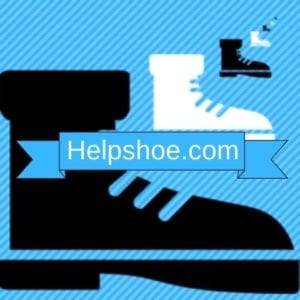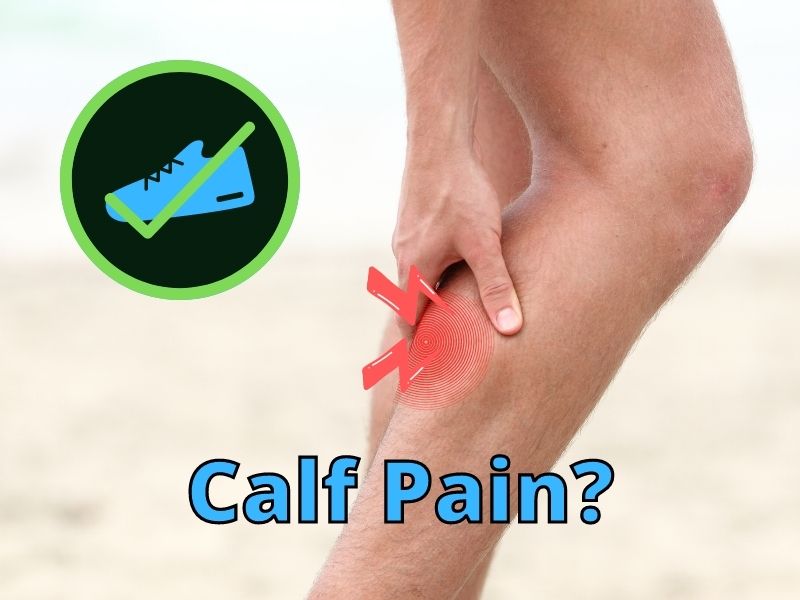Muscle pain for me occurs when I forget to stretch after a run. I soon recognize what I forgot to do and start to stretch my calf muscles after my legs are warmed up a bit. I normally have a habit of stretching after each run, although sometimes something distracts me.
Running shoes can increase or decrease strain on your muscles. Getting shoes that have enough cushion, are flexible, and support your feet will alleviate some pain in your muscle. Other factors also contribute to calf pain and should be identified.
As a runner, I still consider myself a beginner because I don’t run long distances. Although, I have been running long enough to have many pairs of running shoes. The ones that felt the best also had the most cushioning. We’ll discuss what’s happening to cause calf pain and how your shoes might being helping or not.
What’s Causing Your Calf Pain?
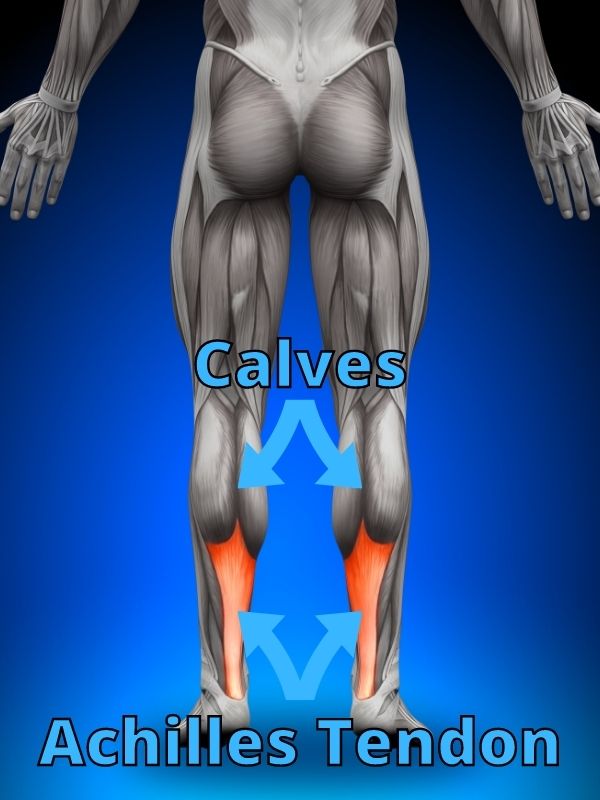
Calf pain can occur in the following ways:
-More likely to occur –
- When we start to get tight muscles it can be painful.
- It can also occur if we pull a muscle or tendon.
- If our tendon is strained too much it can become inflamed and cause pain.
- Weak muscles in your feet. Flat foot can occur with a collapse of the arch.
- Weak muscles in your legs. The legs and core can provide more support if strong.
-Less likely to occur –
- If you’ve had an injury or accident, there could be nerve damage.
- Diabetes can cause nerve damage in your legs.
- From an infection, usually found in sedentary people sitting for long periods.
- Problems with your arteries: Peripheral artery disease and varicose veins.
When pain occurs we should take time to let our legs heal if needed and make sure our calf muscles are loose enough to go out and run again. If you have tight muscles and want to run, just remember that if they are too tight, you’ll likely start to increase the strain on your calf muscle and an injury could occur.
Are Your Feet Causing Calf Pain?
Our calves are comprised of a couple of layers of muscles in the lower back of the leg. These are all considered our calf. Most likely, as a runner, you have experienced muscle tightness and pain at some time.
Before you go out and buy new shoes it’s important to take a good look at your body mechanics. This can include your running style, the strength in your feet, your arches, and how your feet work in your shoes.
The first thing I think is important to look at are your feet. We each have a different level of muscle strength in our feet and different arches.
The shoes we wear can help increase or decrease your foot strength. If you lack strength and don’t have the proper shoes, your feet may lean in.
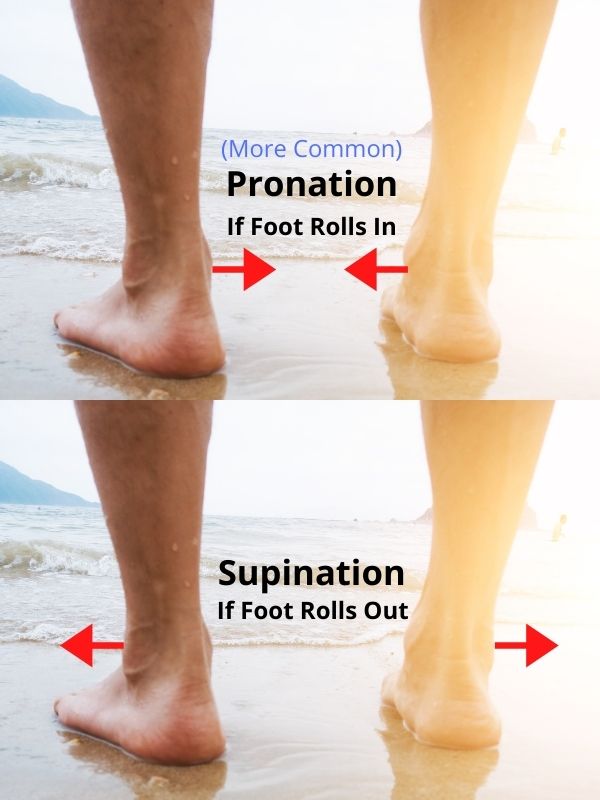
One way to check if your feet are overpronating is to look at the tread wear of your running shoe soles. I tend to supinate when I walk and hike. When I run, I don’t notice any wear difference on my shoe tread.
If you look at the picture below you can see how my shoes looked after walking and hiking in them for about a year.
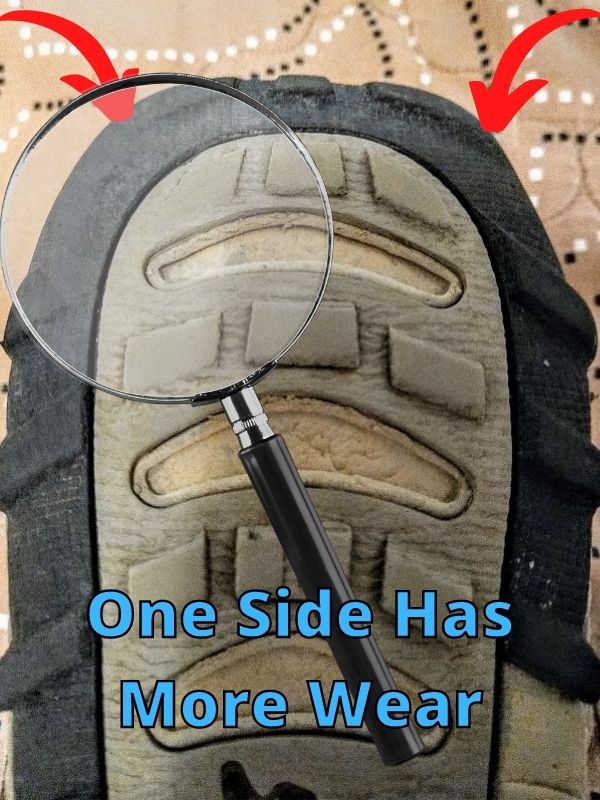
After running for a while you’ll notice a certain wear pattern on your shoes. If the heel section is worn down on one side or the other quite a bit more, your foot is leaning inside or outside.
A common issue that people have when running is to overpronate their feet. Their ankle in leaning inward as they run.
Normally having weak arches is what tends to make people overpronate when they run. If their running shoes aren’t made for overpronation then problems can occur in the joints and muscles. This may be one reason your calf muscles are being strained and have pain
In addition, the overall muscle strength in your legs and core will help support your calves. Doing regular leg muscle strengthening exercises can provide a greater level of calf support and endurance over time. This way you can run longer without straining your calves.
The second thing I think is important to look at are your shoes. We might have the wrong shoes for our foot type. If your feet are flat and need arch support, your shoes need to provide that.
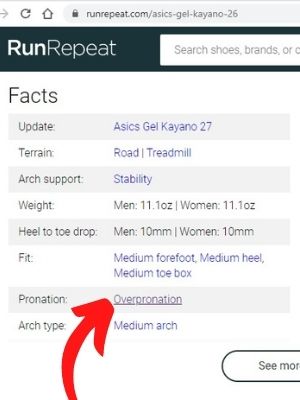
Sometimes I go to runrepeat.com to find shoes that have different attributes I am looking for. It can show the attribute for overpronation or neutral pronation.
You can make sure to get the right shoes that will provide the arch support you need to help your bones align better and cause less strain on your muscles.
If you do have weak muscles and a low arch then you may want to do foot exercises to strengthen your feet.
Sometimes if your feet are out of alignment a physical therapist is needed to help you learn how to exercise and stretch in order to regain proper alignment, especially after an injury.
My feet have gotten stronger as I’ve walked and hiked in zero drop flexible shoes. When your feet are stronger, you have better arch support and can most likely run with less strain, unless there are other issues.
The third and last thing that I think is important to look at is how you run. We all run a bit differently. Some of us run with more of a heel strike, some land more on the arch, and some can run more on the ball of their feet at times.
Generally, you want to avoid landing on your heel as you run. This can lead to knee and hip pain. Some people like to use zero drop shoes because they can help you avoid knee pain if you use them correctly. They tend to help you avoid heel strikes.
Generally, you want to run landing on the midfoot, so your arch can absorb the impact. The foot should roll smoothly from midfoot to push off with your toes.
Some of us tend to land hard on our feet. We keep our legs too straight; sometimes because we get tired or have gotten into a bad habit.
It’s a good strategy to have a bend in knees at all times. That way our muscles can absorb the impact of our running and we have more control as we run.
As I run I notice there are times I want to push myself to reach a goal I have in mind, although those are the times I can cause muscle strain. Taking my time as I run and taking a break when my body needs it helps me avoid problems with my muscles.
As you watch yourself and how you run, you can analyze if you have any issues that need to be corrected, so you can avoid calf muscle pain.
Shoe Attributes for Calf Pain Prevention
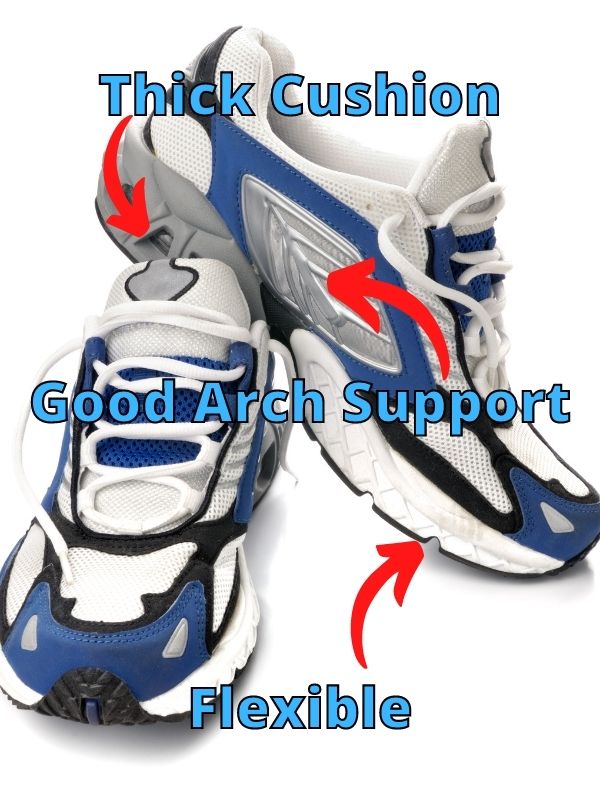
Shoes need several attributes to help prevent calf pain. They should have generous cushioning, flexibility, and enough support for your arch type.
This kind of shoe is generally helpful for all runners because regardless of how strong your foot muscles are, the shoe will do most of the work for you.
If you get a cushioned supportive shoe, you’ll likely avoid some of the problems that can lead to pain in your calf. The shoe will absorb impacts with the ground and keep your arch supported, reducing the impact on your arch, helping reduce muscle strain.
Although your feet may not be getting much stronger, you are helping avoid many problems that could occur if you purchased a shoe that has thin cushioning, rigid sole, and not enough arch support.
Are Zero Drop Shoes Good for Calf Pain?
I found that walking in a zero drop shoe, that allowed my feet to walk in a more natural biomechanical manner, helped strengthen my foot muscles. I have also walked barefoot more often and done more foot exercises to develop stronger foot muscles.
As my muscles get stronger, I am better able to handle running in shoes that have less cushioning and support if I want to. Although, I feel that most runners should wear cushioned shoes that are supportive, so they can avoid problems that can occur with muscle and joint pain.
It’s true that a more minimalist shoe, like many zero drop shoes, can help your feet to function in a more natural way and help your feet get stronger. Although, “They cause at least a 10% increase in calf load compared to a traditional shoe.” (mountainridgept.com)
Have Calf Pain? What Shoes to Get.

If your feet are not ready for minimalist shoes, you could injure yourself. So what’s the best shoe to wear if you already have calf pain? One that reduces the work your foot needs to do and creates a low impact on your muscles and joints.
Check your shoes to see if they are too old. Look at the tread, and think about how many miles they have already gone.
It’s a good idea to have two pairs of shoes that you use when running, so the foam can expand after 48 hours. Then your risk of strain on your calf muscle is reduced.
If you decide to get new shoes, try to find ones that make your job of getting your leg back in a healthy condition easier. Find shoes that can help you reduce strain.
These shoes generally have:
- A thick layer of soft foam that feels comfortable to walk in. In this article you can see different running shoes with EVA and PU foam. EVA is softer, so I might try those first.
- About a 10mm drop from heel to toe, to help reduce strain on the calf.
- A flexible and not too rigid shoe.
- Plenty of arch support.
- A good fit. Make sure to properly size the shoe, to receive the most support.
Warning for New Shoes
Running in new shoes can feel good at first, but there is a break-in period where your feet and legs are not used to a new shoe if it’s different from the ones you had before.
Try running just once a week in your new shoes and continue using your old shoes for up to a month. You can also start walking in your new shoes.
The shoe should be flexible and not too rigid. Many people develop pain in their calves if they run too much in their new shoes.
Which Shoes to Choose for Calf Pain?
If I were to choose a shoe that could help with my calf pain I would look for something that I knew would give me a lot of cushion. I have noticed that having a generous amount of cushioning in my shoes feels very comfortable and relieves joint pain.
I can still get tight muscles, but that happens with any shoe I wear after running. I just need to make sure I stretch after each run. I could run for longer periods and still not feel the impact that occurred on my knees from my less cushioning shoes, even on a short run.
That’s why, in my opinion, a well-cushioned shoe is the best for reducing the strain on the calf muscles. The shoe does the work of absorbing the impact.
If I could buy any shoes today for calf pain, I would probably choose something like one of the following shoes below. One is a road shoe and the other is for trails.
Recommended Shoes
Road Shoe
New Balance 990 v5
This shoe has a lot of cushion, a 12mm heel-to-toe drop, flexibility, and good arch support.
Trail Shoe
New Balance Fresh Foam More Trail v1
This shoe has plenty of cushion, an 4mm heel-to-toe drop, is very supportive, and has a neutral arch (not for those with flat feet).
When I look for a running shoe, I usually go to runrepeat.com and Amazon.com to look at different types of shoes and read reviews.
There are a lot of choices out there. I know the above shoes are not right for everyone. Since I have been on a strict budget, I recently choose to buy the Saucony Raptor TR2 back around April 2020. They have been good hiking and trail running shoes for me. (REVISED – Found out that for any period longer than 30 minutes, these shoes are NOT good support for me.)
The best part about using these shoes is how comfortable they are. There’s plenty of cushions and they feel good on my joints when I use them.
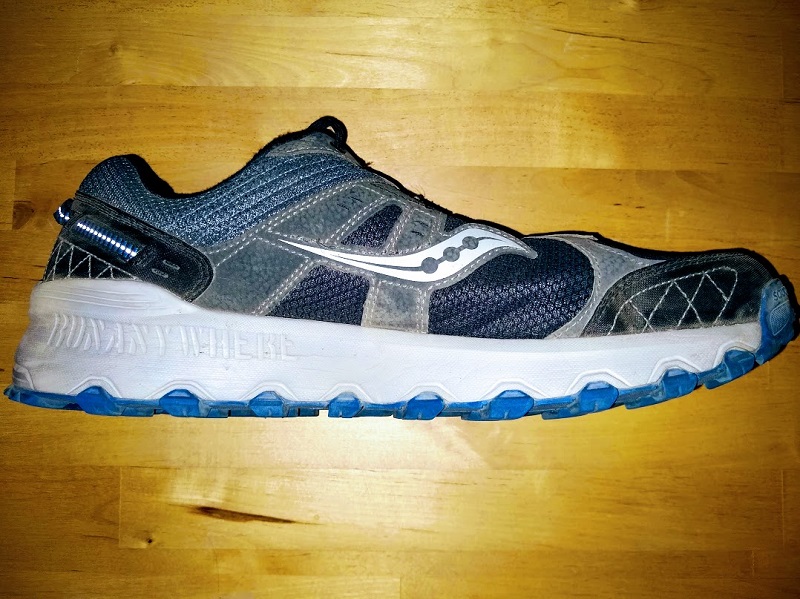
Preventing Calf Pain in the Future
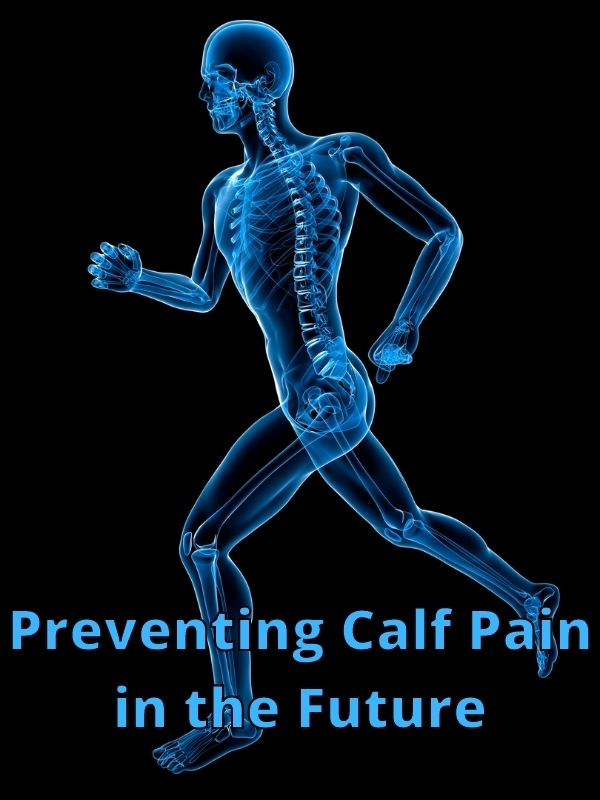
Modifying how you run, getting shoes that help, and exercising your muscles are all ways to help you avoid calf pain in the future.
Doctor’s Visit
Getting a physical exam may not be necessary to avoid calf pain if you know exactly what happened, but you should always be ready to see a doctor if have calf pain that occurs more than once or you’re not quite sure why the pain there.
Doctors can refer you to a physical therapist and help you figure out a plan to heal, exercise, and prevent further injury.
The doctor may be able to find out more about what is going on; just be sure to give them specific details they need to know about the calf pain. This might include how long it been going on, how many times it’s happened, what happened to cause the pain and other medical information that might explain the calf pain.
If you go to a physical therapist’s office, be just as detailed about what happened and make sure to write down questions you have about rehabilitation, exercise, and running.
Running Form
One way to prevent calf strain and injury is to improve your running form.
I have been guilty of pounding my feet into the ground when I am tired. My form gets sloppy and I am not paying as much attention to how my foot strikes the ground. Taking a second to modify my running can make a big difference.
One thing that I’m good at is making sure that I bend my knees as I run. This sometimes comes with a loss of speed, but it’s worth it for me. I can enjoy my run and not worry about getting an injury as much.
If I take a second and think about my arms, I usually find they are working in conjunction with my legs to propel me forward. Sometimes I will get out of sink, but slowing down for a moment can help me make sure I’m getting into a consistent comfortable rhythm.
If the road ahead is bumpy, or you’re on a trail, one way to prevent injuries and stay at a consistent speed is to place your feet purposefully. Like a tennis match, you want to keep your eyes moving back and forth from the ground to directly ahead of you, so your feet land in the most stable areas.
Improving your form will create a lower chance of injury and likely help you run further with more energy. Don’t forget you can always record yourself as you run, to analyze what you might want to work on in the future.
Get Stronger and Stretch
Sometimes all you need is to lift some weights. When people are recovering from an injury, their physical therapist often asks them to keep up a regime of exercise to rehabilitate their leg. This can involve a number of weighted and weightless exercises.
If you like to go running, you want to have stability around your joints and strength in your muscle. Your goal is to build muscle endurance and strength, so you can run as far as you want to and have enough strength and stability to prevent injuries.
Runners can benefit from doing squats, lunges, planks, and I like to use the leg extension machine to add stability to my knees. Some people feel leg extensions have no real application in real-life situations, although I feel it creates great stability for me personally, helping prevent injury.
If you have injured your calf, remember to be cautious and to wait until it is healed before beginning an exercise weight lifting program. Re Injury is common for those trying to exercise to0 soon.
Stretching
As mentioned earlier, stretching is important for preventing tight muscles. Each time you exercise or run a regular stretching routine is important.
Stretching your calves will be a priority since they are a problematic area.
If your muscles are tight, resist the urge to exercise and warm up your legs and stretch out those tight muscles before you run or start your exercise routine.
Get the Right Shoes
If you experience calf pain, one of the best things to do is go to a running store. Most likely the customer service representatives will be runners or have some information about running shoes that you help you find the best shoe for your needs.
You may want to explain why you are looking for a new running shoe, that way they may be better able to help you find the exact shoe that will help you when running.
Make sure to think about questions you have before going to a running shoe store, so you make an informed choice. Don’t be afraid to say leave without a purchase, if you’ve been there a while and still haven’t found the shoe that meets your need.
It’s worth it to take some more time to get a shoe that fits right and provides the support you need.
Final Thoughts
If you’ve figured out why your calves are hurting, that’s half the battle. Now you can move forward with a specific plan to get your calves in good shape.
Choosing the shoes that are most helpful for your situation can help prevent problems in the future. Take caring of your calves by strengthening and stretching your feet and legs can also lead to pain prevention.
Best wishes for healthy calves and getting the shoes that best serve you.
